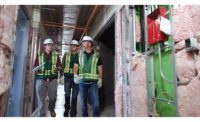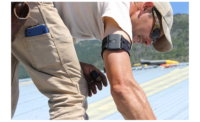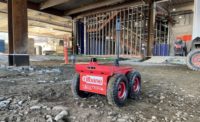Getting connected on a jobsite was once a matter of trying to find a decent cellphone signal. But innovations in wireless mesh networks, sensor technology and data analytics now can offer a new level of intelligence and contextual awareness to workers on the site. And some contractors are diving right in, running pilot projects with the latest smart devices.
“This wave of connected jobsite technologies is one of the most exciting opportunities we’ve had in recent years,” says David Burns, director of field solutions for McCarthy Building Cos., which has been testing advanced sensor technology on its jobsites.
But putting a sensor on everything isn’t a solution in itself, notes Burns. “There have been a number of situations that arose as we were piloting where we had to dig a bit deeper into what specifically was being tracked,” he says. Burns recently oversaw a pilot project, run by McCarthy, that used sensors to record ambient and environmental data across the jobsite. “It’s very much a learning experience for us,” he says.
McCarthy deployed wireless environmental sensors from tech start-up Pillar Technologies on an expansion project at Mercy Hospital in St. Louis. The mounted sensors measure ambient qualities, such as temperature, humidity and dust-particulate levels, as well as noise and vibration. But the data is not simply logged for future records. Burns and his team receive real-time alerts when a wireless sensor detects something amiss on the site. “Sometimes it’s driven by a contract requirement for noise or vibration, but the platform could also be used to mitigate risk,” notes Burns. “It can detect smoke or a rise in temperature, provide an early indicator of damage to materials and avoid the need for rework.”
“We have to ask ourselves, what is it that we’re tracking and how is it useful?”
– David Burns, Director of Field Solutions, Mccarthy Building Cos.
While tracking on-site conditions with basic sensor packages is nothing new, Burns began to refine the data once McCarthy started collaborating more directly with Pillar Technologies. “When we start to look to an ‘internet of things’ [IoT], we have to ask ourselves, what is it that we’re tracking and how is it useful?” he says. “OK, we can track dust particulates, but to what degree? We found that Pillar was very responsive in building out sensors that fit our needs.”
Burns says that, once the Pillar team fine-tuned the sensors to what the project managers needed to know on the site, work started to accelerate on the hospital project. “Their agility really impressed me. As they rewrote the software and firmware, we saw the chance to adjust sensors to fit any type of project we might be working on—hospitals, solar farms—really, anywhere we self-perform work and know what we want to know.” Once more projects begin to record rich data on every aspect of the job, the benefits from analysis will begin to stack up, Burns says. “Over time, we’ll aggregate this data, and what’s not a problem today may actually be an indicator of a problem tomorrow,” he says.
Going for Total Jobsite Coverage
Sensors that can send an alert when they notice something amiss are the low-hanging fruit of connected jobsites. Some firms and manufacturers are aiming quite a bit higher. From November 2016 to February 2017, Mortenson Construction ran a connected jobsite pilot on a project at the Penn State campus, State College, Pa., in which it ran trials on a comprehensive wireless mesh network with IoT capabilities.
While building an expansion to one of the university’s athletic facilities, the team deployed a prototype of a jobsite wireless connectivity solution, made by the tool company DEWALT. Using a series of relays, the system generated a wireless mesh network across 100,000 sq ft of the jobsite, providing high-speed internet access to everyone on site without the need for cell or satellite signals. Linked to a high-speed, wired connection in the jobsite trailer, the system required only one or two nodes per floor, driven by external power or DEWALT battery packs.
“It was the first time we’ve blanketed the jobsite from corner to corner with a WiFi mesh,” says Taylor Cupp, technologist at Mortenson Construction. “We needed that connectivity, and now we had it. The object is to keep our people in the field, instead of making trips to the trailer to get the latest information.” Foremen and superintendents were able to quickly download the latest construction documents and project management files. “We opened it up to our subcontractors—mechanical, electrical—using BIM 360 Glue for the VDC and BIM, and they were able to have constant access to the model,” says Cupp. “For the project management side, we were able to use Procore anywhere on the site to get the latest project information.”
DEWALT has been quietly developing a jobsite connectivity solution for some time, and while it is new territory for the company, it is also a natural extension of its brand, says Tony Nicolaidis, vice president of marketing for DEWALT. “First step is a wireless mesh network, ruggedized for the jobsite,” he says. “But down the road, we’ll launch our IoT platform. Then, we’ll be able to track where assets are—our products or anything that’s tagged—across this mesh network down to a floor or specific zone.” DEWALT is looking into not just providing real-time updates but also automatically generating summary reports tailored to team members’ requirements.
“I can’t think of anything on a jobsite that doesn’t rely on locational awareness.”
– Taylor Cupp, Technologist, Mortenson Construction
With a site blanketed in DEWALT’s WiFi, Nicolaidis imagines a scenario in which Bluetooth-enabled DEWALT tools, tagged materials and even workers with badges will be passively tracked. During the pilot at Penn State, Cupp saw the earliest stages of this vision. “We tested out some of the IoT features,” he says. “There are so many opportunities to track data and collect it in the field. I can’t think of anything on a jobsite that doesn’t rely on locational awareness.”
Cupp says the real value of the system was having a single solution for tracking and wireless, as the team should have as few layers of software and log-ins as possible to access the data. DEWALT’s in-development system sent out alerts and push notifications, and even the basic analytical data it generated showed promise. “It was very interesting when we started to overlay where people were versus equipment and started to take a lean approach—how to avoid wasted movement and underutilization of equipment,” Cupp says.
While the system used on the Penn State site was very much a work-in-progress version, Nicolaidis says the ready-for-deployment wireless solution is near. DEWALT plans to announce more details about its product at ENR’s FutureTech conference in San Francisco, held from May 29 to June 1.
Working Safer, Connected
Worker tracking can be used for more than improving efficiency. Tech start-up Triax Technologies is starting to get its belt-mounted sensor out in the field (ENR 11/7/16 p. 99). Now it is seeing how data gathered while tracking workers can improve safety. Based on a local mesh network, the device, whose batteries last a year, logs worker movements only while they’re on site.
The firm’s “spot-r” system clips to a worker’s belt and features accelerometers and gyroscopes that can detect sudden falls or motions. It has an alert button for workers to signal for help or when they see an unsafe condition.
“Now that we’re collecting data on a larger scale, we’re starting to see new ways to improve worker safety,” says Chad Hollingsworth, Triax co-founder and president. “There’s been excitement among workers about using the alert to point out hazards on the site.”
The system’s logs of worker movements also brought new insights into safety practices. “On one job, we saw a lot of small falls around where they were doing the rebar for concrete,” recalls Hollingsworth. “Turns out, the guys were jumping into the pit instead of using the ladder, and the safety manager was able to tell them to use the ladder, based on that aggregated data.”
Sifting Through the Info Overload
While sensor technology has gotten cheaper and more durable, processing the mountains of data generated by connected sites remains an issue.
DPR Construction has run its own pilot projects for sensors, but it also is developing the back end that will help to make sense of the information. “We don’t necessarily know what’s going to happen with IoT, but we’re working on the back-end platform in Microsoft Azure so data from any sensor can be ingested and analyzed,” says Kyle Shipp, MEP coordinator for DPR Construction. “If we can develop that capability and tie it to our display dashboards, we’ll be well ahead.”
“The goal is for any sensor data to flow into the real-time analytics system.”
– Kaushal Diwan, Head of Innovation, DPR Construction
Shipp has been leading DPR’s sensor pilots, even building from scratch some of his own environmental sensors. But the bulk of the work has been in Microsoft Azure’s cloud-computing environment and PowerBI’s dashboard visualization platform so that meaningful insights can be gleaned from new information.
“There are no limits on the type of data you can collect,” says Kaushal Diwan, head of innovation for DPR. “The next step is applying machine learning to get predictive analytics and make smarter systems.”
DPR has begun integrating BIM 360 into its PowerBI dashboard. Also, it is looking to bring in data from worker-tracking systems. “The goal is for any sensor data to flow into the real-time analytics system,” says Diwan.
With more and more data coming into DPR’s back end system, Diwan says he is looking beyond the construction phase to the whole life cycle of a building. “On one side, it’s understanding the micro-ecosystem of the project, being more aware of the specific dangers of that site and climate,” he says. “But if we can tie this data into what we hand over to the owner when we close out projects, it becomes the handover of a smart building.”














Post a comment to this article
Report Abusive Comment